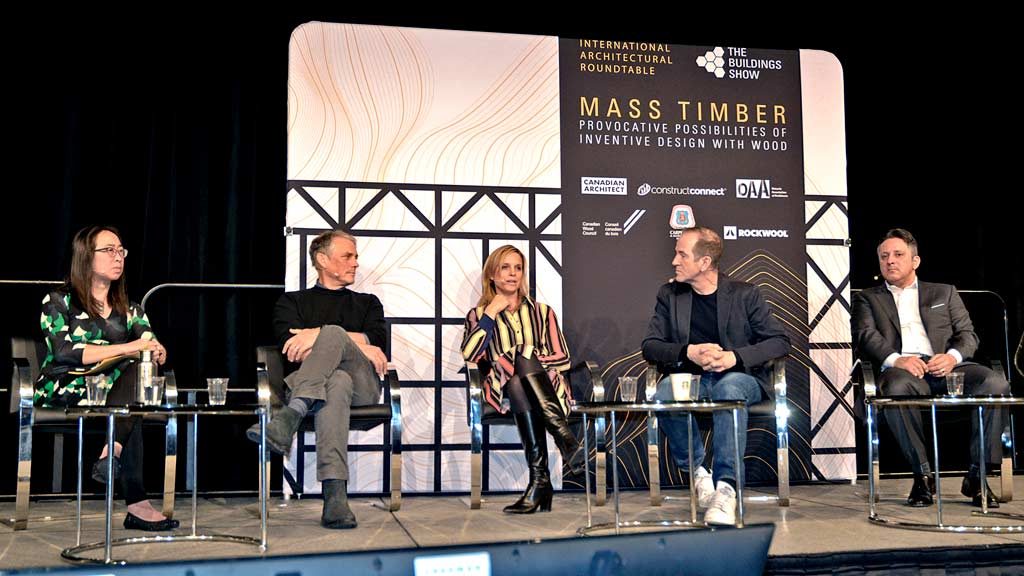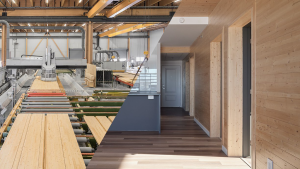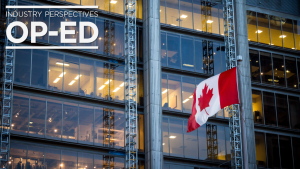Mass timber construction is on the rise in Canada and around the world and architects are finding creative and innovative ways to integrate it into their building designs.
Architects who took part in the International Architectural Roundtable held at The Buildings Show in Toronto Dec. 4 pointed out that the building and construction industries are responsible for about half of all greenhouse gas emissions in the world and that it’s time for change. Also, it is time for architects to be advocates for low carbon construction.
“As an architect you can be part of the problem or part of the solution,” stated Andrew Waugh, founding director at Waugh Thistleton Architects in London, U.K.
“The reason why we do this is all about climate change. It’s not just about the architecture and it’s not just about the operation of these buildings, we need to really seriously consider the materials, the process and the culture in the buildings we provide.”
The session was billed Mass Timber: Proactive Possibilities of Inventive Design with Wood.
“Mass timber and wood construction can be used to sequester the carbon and will contribute to addressing the problem and solving the problem rather than worsening it,” explained Elsa Lam, editor of Canadian Architect Magazine, who moderated the panel. “Since Canada has so many well-managed forests and produces wood it seems natural that we should be advancing our community on mass timber, how to use it and deploy it.”
Alan Organschi, principal at Gray Organschi Architecture, agreed mass timber construction is the future.
“What I’m really interested in is not only emissions but the capacity of materials to store carbon,” he said. “When you start to compare these systems, you see that timber starts to perform really well.”
He talked about a 14,000-square-foot addition he completed at Common Ground High School in New Haven, Connecticut integrating sustainable design to reduce its carbon impact. It features a mass timber structure with a prefabricated system of wall and roof components.
Let’s not ever limit our thinking of putting timber in buildings
— Do Janne Vermeulen
Team V Architecture
The challenge, he said, was integrating the new building into the fabric of farm buildings, agricultural fields, forests and wetlands that surround the property.
“We said we want to load as much carbon into this building as possible,” he noted. “We wanted to give it as much primary structural material as possible so they can really understand exactly what the building was made out of.”
Haut is a 73-metre, 21-storey hybrid timber and concrete high rise under construction in Amsterdam.
Once complete it will store 2,200 tonnes of CO2. While the primary building material is timber, the basement, ground floor, first floor and core of the building are made of concrete and every floor has a layer of concrete for sound, explained Do Janne Vermeulen, founding partner and architect at Team V Architecture in Amsterdam.
“To create these sorts of buildings we have six to-dos on our list: build healthy, active urban spaces, create high quality public transport, build tall, do not demolish, build multi-functional buildings; and engage and customize,” said Vermeulen, adding timber can be used to build on top of existing buildings.
The firm was selected to build the tower following a competition by the municipality.
“We didn’t win because we put the highest financial bid, we won because we had the best proposal for a sustainable and architectural building,” she noted. “This is where the government can really help make a change in the way we build.”
“Let’s not ever limit our thinking of putting timber in buildings,” she added. “Even if they are complex initiatives, we should still aim figure out how we can include timber in our infrastructure.”
Waugh spoke about a project he worked on called Dalston Works, a 10-storey 121-unit development and the world’s largest CLT building in London.
“As well as tackling London’s need for high quality, high-density housing that provides a natural and healthy living environment, this groundbreaking use of timber technology has significantly reduced the carbon footprint of the building in terms of both material production and on-site time and energy consumption,” states the architect’s website.
Hullmark Development’s five storey 80 Atlantic project in Toronto’s Liberty Village neighbourhood is the first new timber-frame commercial building to be constructed in the city in over a generation, explained Richard Witt, principal at Toronto-based Quadrangle.
He said the vision was to take the best attributes of post and beam construction such as beautiful, bright and warm and combine it with the best characteristics of new concrete office towers such as technologically equipped, customizable, contemporary amenities, clean and energy efficient.
“We thought ‘why do we have to choose one or the other, why can’t we have both,’ ” said Witt.
“We didn’t begin by saying it has to be a wood building. It turned out that using timber is equal to 22 years of operational energy which is huge.”
He had some advice for the delegates in attendance.
“It’s very easy in all of these projects to say ‘no,’ but what if we all say, ‘yes it can be done, it should be done’ and be the ones to lead it,” said Witt.
Follow Angela Gismondi on Twitter @DCN_Angela.











Sounds like a coupe of deforesters feel smug about climate change.